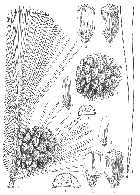Line drawing (Li 1975).

Line drawing of var. massoniana; for full size image go to the Flora of China (Wu and Raven 1999).
Line drawing (Li 1975).

Line drawing of var. massoniana; for full size image go to the Flora of China (Wu and Raven 1999).
Pinus massoniana
Horsetail pine; Chinese red pine (Liu 1970); Vietnamese: Thông duôi ngua, Thông tàu (FIPI 1996); 马尾松 ma wei song [Chinese] (Wu and Raven 1999); タイワンアカマツ [Japanese].
Syn.: P. massoniana (Lamb.) Opiz 1839, (Farjon 1998). Three varieties:
Pinus massoniana Lamb. var. massoniana. Syn: P. sinensis D. Don in Lambert 1828, P. nepalensis J. Forbes 1839, P. canaliculata Miq. 1861, P. calavierei Lemée & Lév. 1910, P. argyi Lemée & Lév. 1910, P. argyi var. longe-vaginans Lév.; P. crassicorticea Y.C. Zhong & K.X. Huang 1990 (Wu and Raven 1999).
Pinus massoniana Lamb. var. hainanensis Cheng & Fu 1975. [No synonyms.]
P. massoniana Lamb. var. shaxianensis D.X. Zhou 1991 (placed in synonymy with var. massoniana by Farjon (1998) but retained by Wu and Raven (1999).
Trees 18-45 m tall and up to 150 cm dbh, the trunk crooked, forming an irregular, usually broad head. Bark red-brown toward apex of trunk, gray- or red-brown toward base, irregularly scaly and flaking, or longitudinally and deeply fissured or cracked, furrows up to 4 cm. in depth, 3-4 cm. in width, ridges flat-topped, sometimes transversely fissured into flat plates, 3-5 cm. wide, exfoliating in spline-shaped flakes; lenticels inconspicuous; outer bark up to 5 cm. thick, hard and brittle, ligneous, with a reddish brown tiered cross section; newly formed periderm yellowish brown; inner bark 3-5 cm thick, finely fibrous, pale red, secreting transparent resin after cutting, cambium and newly formed phloem colorless, somewhat transparent. Freshly cut sapwood pale yellowish white to pale orange red, wood rays inconspicuous. Branchlets usually growing twice per year, yellowish brown, occasionally glaucous. Winter-buds brown, ovoid-cylindric or cylindric, tip acute. Needles 2(-3) in a fascicle, slightly twisted, 12-20 cm long, stomatal lines on all surfaces, slender, pale green, semicircular in cross section, with 2 vascular bundles and 4-9 marginal resin ducts; base with persistent sheath. Female cone matures in two years, ovoid, conical-ovoid, or ovoid-cylindric; (2.5-)4-7 cm long and 2.5-4(-5) cm wide, pendulous, shortly pedunculate, green when young, turning chestnut brown at maturity. Cones scales suboblong-obovoid or rhomboid, flat, apophyses rhombic, slightly swollen or flat, slightly transversely ridged; umbo flattened, slightly sunken, blunt or shortly mucronate in apical part of cone; scale usually spiny in arid areas. Seeds brown, winged, narrowly ovoid, 4-6 mm long, 1.5-2.1 cm long including the wing. Cotyledons 5-8; newly appeared leaves flat, 1.5-3.6 cm long, margin hair-like spiny. Pollination April-May, seed maturity October-December of second year (Liu 1970, Li 1975, FIPI 1996, Wu and Raven 1999).
Key To The Varieties (Wu and Raven 1999):
1a. Umbo spiny: var shaxianensis. | |
1b. Umbo usually flattened or obtuse. | |
2a. Seed cones ovoid or conical-ovoid; bark gray-brown toward base of trunk, irregularly scaly and flaking: var. massoniana | |
2b. Seed cones ovoid-cylindric; bark red-brown, irregularly flaking: var. hainanensis | |
Taiwan, China: Anhui, Fujian, Guangdong, Guangxi, Guizhou, Hainan, W Henan, Hubei, Hunan, S Jiangsu, Jiangxi, SE Shaanxi, Sichuan, Taiwan, E Yunnan, Zhejiang; occurs from plains to mountains, from near sea level to 2,000 m elevation (Wu and Raven 1999). Hardy to Zone 7 (cold hardiness limit between -17.7°C and -12.2°C) (Bannister and Neuner 2001). It has been planted in some provinces of Vietnam, such as Ha Tay (Da Chong), Ha Bac (Phan Son), Thanh Hoa (Phu Dien) and Quang Ninh (Yen Lap). Light and humid-demanding tree, that cannot tolerate shade. Root system is deep. Growing on deep and well-drained soil but also met on poor soils and on bushy hills. Fast-growing at the first stage, later gradually slow-growing. Usually forming pure stands, or mix with other light-demanding tree species. Flowering in April, fruits mature in November-December of the following year (FIPI 1996).
Var. massoniana found in Taiwan and China: Anhui, Fujian, Guangdong, Guangxi, Guizhou, W Henan, Hubei, Hunan, S Jiangsu, Jiangxi, SE Shaanxi, Sichuan, Taiwan, E Yunnan, and Zhejiang (Wu and Raven 1999).
Var. hainanensis is only found in the hills of Hainan, where it is rare and endangered (Wu and Raven 1999).
Var. shaxianensis is only found in Fujian (Sha Xian) (Wu and Raven 1999).
The oldest reported living tree was 255 years old (crossdated) in 2016, growing on Gu Mountain of Fujian (Li et al. 2016). This was part of a dendroclimatic study; 87 trees were sampled in a stand of old-growth P. massoniana, and the results used to evaluate the climate-growth response.
Sapwood and heartwood distinctive: heartwood yellow-brown, veins coarse, straight, wood light (density 0.39-0.49). Used in construction, for mining poles, matches, ordinary furniture, boxes and underwater construction (on land, it is easily attacked by termites and insects). Wood contains 62% of cellulose and can be used for paper and artificial fibres. The resin is resource for industry and medicine (FIPI 1996).
An important tree for afforestation in S China. The timber is used for construction, railway sleepers, mine timber, furniture, wood pulp, etc., and the trunk as a source of resin and tannin, and for cultivating fungi (Wu and Raven 1999).
Lambert, A. B. 1803. A description of the genus Pinus, illustrated with figures, directions relative to the cultivation, and remarks on the uses of the several species. London: J. White.
Li, Yingjun, Keyan Fang, Chunfu Cao, Dawen Li, Feifei Zhou, Zhipeng Dong, Yu Zhang, and Zhanfeng Gan. 2016. A tree-ring chronology spanning 210 years in the coastal area of southeastern China, and its relationship with climate change. Climate Research 67(3):209-220.
The species account at Threatened Conifers of the World.
Huang 1994 (the Flora of Taiwan).
Last Modified 2023-10-31